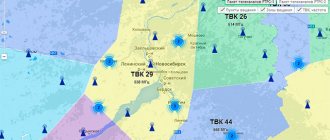Digital terrestrial television in the Chelyabinsk region
Free digital terrestrial television is available to everyone
Today, residents of the Chelyabinsk region can watch digital terrestrial television for free. RTRS-1 are available in excellent quality : “Channel One”, “Russia 1”, “Match TV”, NTV, “Petersburg-5 channel” “Russia K”, “Russia 24”, “Carousel”, “Public Television of Russia”, “TV Center”, as well as three radio channels: “Vesti FM”, “Mayak” and “Radio Russia”, as well as RTRS-2 (STS, TNT, RenTV, Pyatnitsa, Spas, Home, Star, TV3, Mir, MuzTV).
Digital terrestrial television is a new stage in the development of television throughout the world, which replaces analogue television broadcasting. Analogue television is significantly inferior to digital television in terms of picture and sound quality and at the same time requires a large frequency resource. Therefore, further development of the “analogue” is technically and economically inappropriate. From 2021, “analog” will be gradually replaced by “digital” until complete shutdown, as has already been done in many countries around the world. A digital terrestrial signal is available regardless of the distance and size of the settlement. At the same time, unlike users of cable and satellite operator networks, viewers of digital terrestrial television do not pay a subscription fee for television viewing.
To transfer television and radio broadcasting networks to digital technologies in Russia, a federal target program “Development of television and radio broadcasting in the Russian Federation for 2009-2018” has been developed. As a result of the implementation of this program, reception of mandatory public television channels without a subscription fee will become possible in all populated areas of Russia.
To receive free digital terrestrial television, it is enough to purchase a UHF antenna (collective or individual, outdoor or indoor, depending on your living conditions). Most modern TVs support the DVB-T2 broadcast standard, which broadcasts free multiplexes. If the TV is an old model, you will need to additionally install a special digital set-top box. Purchasing user equipment for receiving a digital terrestrial signal is a one-time procedure. The cost of a decimeter antenna starts from 300 rubles, a digital set-top box – from 700 rubles. The antenna, set-top box and connecting antenna cable can be purchased at electronics stores.
The shutdown of analogue federal TV channels in municipalities of the Chelyabinsk region will occur on October 14, 2021.
Center for consulting support for the population in the Chelyabinsk region
Specialists from the RTRS Consulting Support Center (CSC) in the Chelyabinsk region are ready to answer questions about digital television and explain how to choose and connect receiving equipment correctly.
Questions about connecting to digital broadcasting can also be asked 24/7 via the toll-free federal hotline number: 8-800-220-2002.
Detailed information on the website https://chelyabinsk.rtrs.ru.
map.rtrs.rf:
10/08/2018 at 22:21
Review of seven days. Distrustful Nyazepetrovites and the transition to terrestrial digital television
08.10.2018
It seems that not only the authorities, but also the population in the very outback of Russia are beginning to realize that the transition to digital broadcasting is just around the corner - literally in three months.
This is evidenced by the fact that publications about the transition to digital are beginning to appear in regional newspapers.
There is such a city in Russia as Nyazepetrovsk and the area surrounding it.
We bet that 99% of our readers, and readers in general, never knew that such a city and region existed.
But it exists (and this is a fact, and you cannot go against it), and it is located in the Chelyabinsk region.
The regional center is the town of Nyazepetrovsk with 11 thousand inhabitants, located 225 km from Chelyabinsk and 180 km from Yekaterinburg.
The local regional newspaper “Nyazepetrovskie Vesti” published a report on 10/04/2018 about the transition to terrestrial digital television in the city and region.
True, the title of the report is as if we are talking about a new duty introduced by the state that Nyazepetrovsk residents must fulfill: “Residents of the Nyazepetrovsky district will have to switch to digital television.”
The report is interesting because it shows how the process of transition to digital is now being understood, as they say, in the very, very outback of Russia.
It is noteworthy that the material was published in the newspaper section “The Main Thing,” which is not surprising - for the Russian outback, watching TV is one of the main entertainments - and here TV channels may disappear, so we have to put materials about the transition to digital in the “main thing” section.
The report begins with the statement:
“When it comes to connecting a TV to digital, many residents of the Nyazepetrovsky district think that this is a very complicated process that only professionals can do.”
Next, the author tries, as best he can, to encourage his fellow countrymen:
“In fact, this procedure does not require time or much effort. Only costs, and even then small ones.”
A lively journalist from Nyazepetrovskie Vesti decides to go to a local store that sells electronics to write her material.
She writes:
“Most modern TVs support the DVB-T2 broadcast standard, which broadcasts free multiplexes; in this case, installing an additional device is not required. Just connect the antenna and switch the TV to digital broadcasting mode.
But what if your TV is old? Run to the store for a new one? Of course not.
In order to connect digital TV and take full advantage of its benefits, it is enough to purchase several devices from an electronics store.
In Nyazepetrovsk, this can be done, for example, in “Domovenka”, located at the address: st. Karla Marksa, 18 (next to the employment center).
That’s where I went to find out how to choose the right devices and how to connect them myself.
“When information appeared about the transition to digital, both urban and rural residents immediately began buying set-top boxes and antennas in our store,” says the Domovenka salesman. — And now, when we are talking about 20 digital channels, they are also actively purchasing. They buy and ask: will we have these 20 channels?” End of quote.
This is how they are, the Nyazepetrovites - incredulous. They buy and think, will we have these 20 channels?
As far as one can understand, many people watch television in Nyazepetrovsk now.
The newspaper explains to fellow countrymen that the capabilities of a receiver are determined by its price.
Despite the fact that “the most affordable receivers do not support additional functions, while more expensive devices have a small amount of memory and are able to work with flash drives.
Also, some models have the ability to record streaming video to removable media.
The local Domovenok store offers a wide range of receivers.
Their cost starts from 700 rubles, a decimeter antenna - from 500 rubles,” the newspaper writes.
And as almost everywhere, in this corner of the Chelyabinsk region it turns out that there are white spots covered with an on-air digital signal.
What can I say, the “Russian Television and Radio Broadcasting Network” (RTRS) did a great job (value judgment), which for several years was engaged in the construction of a network of on-air digital transmitters across Russia - everywhere you look, everywhere there are settlements where the on-air digital signal “does not reach.”
“Nyazepetrovskie Vesti” also writes about this in the mentioned material, but without criticism or generalizations - a state newspaper:
“In the Nyazepetrovsky district, the digital signal will not reach 6 settlements. These are Sitseva, Grivenka, Aptryakova, Sukhovo, Kotovo and Nesterovo. The only solution for residents of the listed villages is the installation of satellite dishes. Residents need to contact the administration of their settlement to apply for the purchase of satellite receiving equipment under special conditions. Applications will be submitted to the regional Ministry of Information Technologies and Communications.
In total, free digital television in the Chelyabinsk region will be unavailable to 37 thousand people from 142 settlements.”
Note that (as far as we know) in the Nyazepetrovsky region, ordinary residents of settlements where the airwaves “do not reach” will have to buy equipment for receiving satellite signals at their own expense (although they will be given a small discount).
Answer
New era
October 14, 2021 will go down in the history of the Southern Urals as the day when the region took a huge step towards new, digital technologies. At the Chelyabinsk Regional Radio and Television Transmission Center, outdated analog television broadcasting was switched off. Together with other regions of the country, the Chelyabinsk region has entered the era of digital television.
To monitor the region's transition to a new format of television and radio broadcasting, a government commission arrived in the Chelyabinsk region.
The commission included Deputy Director of the Department of Digital Technologies of the Ministry of Industry and Trade of Russia Maxim Mamsurov and the plenipotentiary representative of the General Director of FSUE RTRS in the Urals Federal District, Director of the Internal Audit Department of FSUE RTRS Vladimir Shurupov.
The commission will work in the region for three days. On Monday, October 14, a solemn ceremony to switch off outdated analog television broadcasting took place at the Chelyabinsk Regional Radio and Television Center.
“We actually already live in the digital era. This is a different quality of life, completely different opportunities. It is important that they are available to all residents of the Chelyabinsk region, so that there is no digital inequality between people,” commented the Minister of Information Technologies and Communications of the Chelyabinsk Region Alexander Kozlov . According to him, from today the entire region, including the most remote settlements, is entering the digital era.
As Vladimir Shurupov, the plenipotentiary representative of the general director of RTRS in the Ural Federal District, said, today 209 analogue transmitters have been switched off in the Chelyabinsk region. “FSUE RTRS has built over 5 thousand transmitting stations from Magadan to Kaliningrad so that the entire population of Russia can watch digital television. Today we put an end to the history of analogue television broadcasting,” Shurupo .
In the Southern Urals, the digital terrestrial television network in the Chelyabinsk region includes 73 transmitting stations. The construction and operation of the digital terrestrial television network is carried out by the RTRS branch "Chelyabinsk ORTPTS".
Residents of South Urals are fully provided with digital set-top boxes, which are necessary to connect digital television. You shouldn’t expect rush demand and price increases, says Maxim Mamsurov . “The regional authorities have done a tremendous amount of work, which has made it possible to prepare the region at a high level for the transition to digital.” An awareness-raising campaign, call centers, volunteers - everything was done to ensure that South Urals residents did not experience difficulties as a result of replacing analogue with digital. Together with the Chelyabinsk region, today another 20 constituent entities of the Russian Federation are switching to digital television broadcasting,” noted Maxim Mamsurov .
Participants of the government commission also visited the city volunteer center and got acquainted with the work of the hotline. In the evening, the regional government held a meeting of the operational headquarters led by First Deputy Governor of the Chelyabinsk Region Viktor Mamin , at which participants discussed the current situation regarding the transition to digital television broadcasting in the Chelyabinsk Region.
The commission concluded the first day of its work with a demonstration of the architectural and artistic lighting of the Chelyabinsk television tower, which has become another striking landmark of the city.
Today, members of the government commission for monitoring the transition to digital television and radio broadcasting will pay a working visit to Miass.
Reference.
Digital television has a number of advantages over analogue television: it is more resistant to interference, requires less frequency resources, and has better picture and sound quality. 98.94% of South Urals residents can watch federal channels in digital format for free. These are “Channel One”, “Russia 1”, “Match TV”, NTV, “Petersburg-5 channel” “Russia. Culture", "Russia 24", "Carousel", "Public Television of Russia", "TV", "TNT", "RenTV", "Friday", "Spas", "Domashny", "Zvezda", "TV3", " Mir", MuzTV.
To connect digital television, it is enough to purchase a special device - a DVB-T2 receiver (decoder). Owners of the latest TV models released after 2012 do not need such a set-top box; it is built into the TV body. Those who have cable TV or a satellite dish will also not need additional equipment. Operators will configure the digital signal themselves.
Starting from October 14, those residents of the region who have not switched to digital will see on their screens for a week an information message about the need to connect to digital television broadcasting with recommendations on what needs to be done in order not to be left without mandatory public television channels. On October 22, analogue transmitters will be switched off.
For those who bought a digital set-top box but cannot connect it themselves, there is a hotline for issues related to the transition to digital broadcasting at 8-800-220-20-02. Specialists will advise on connecting equipment or accept requests for volunteer help. In total, there are over 3 thousand “digital” volunteers in the region, they provide free assistance to South Urals residents.
Photo: Marina Vlasova
Digital educational program. South Urals residents were told how to tune in to digital television
“We are not talking about a simultaneous transition to digital broadcasting, this is not some kind of action of flicking a switch,” says Alexey Ivonin. - The point is this. Now in our country, including the Chelyabinsk region, there is analogue television and radio broadcasting. Each locality has transmission facilities that operate one or more television and radio broadcast transmitters. At different frequencies. In 2009, Russia launched a federal target program for the transition to digital broadcasting, which will be completed at the end of this year. As part of its implementation, we built 73 transmission facilities in the Chelyabinsk region. Most of them are built on existing analogue network infrastructure, meaning we installed additional transmitting antennas and additional television transmitters, two at each station. — How do these transmitters differ from analog ones?
— An analog transmitter can transmit only one TV channel or radio program on one frequency, while a digital transmitter can transmit ten at once. That is, if we broadcast a total of 15 analogue television programs, then this requires 15 transmitters and the same number of carrier frequencies. Now, to broadcast ten programs from one multiplex, one transmitter and one frequency are needed. This is important in terms of saving private resources.
— What is a multiplex?
— Multiplex in technical terminology means a package of programs and services. The TV receiver or set-top box, having received the digital signal, unpacks this package, and the TV viewer selects any program from ten. We built two such multiplexes as part of the federal program.
— What channels do they include?
— As part of the first multiplex “Channel One”, “Russia 1”, “Match TV”, NTV, “Petersburg-5 channel” “Russia K”, “Russia 24”, “Carousel”, “Public Television of Russia”, “TV Center”, as well as three radio channels: “Vesti FM”, “Mayak” and “Radio Russia”. The channels of the second multiplex, which are STS, TNT, RenTV, Pyatnitsa, Spas, Domashny, Zvezda, TV3, Mir and MuzTV, will be received by South Urals residents by the end of this year. I would like to draw your attention to the fact that today almost 99% of residents of the Chelyabinsk region can watch digital television. Of course, having previously configured your television receivers.
— But not every TV can receive a digital signal?
— Multiplex channels are broadcast in the DVB-T2 broadcast standard, this standard is supported by most modern TVs. I don’t see any point in deciphering this thing, just remember these letters. This is a completely new standard. Initially, Russia wanted to go with the DVB-T standard, but several years ago a government commission finally decided to deploy a network in the DVB-T2 format. This technology makes it possible to transmit more programs in one package. DVB-T allowed the transmission of six channels, and DVB-T2 - ten.
— Is it time for South Urals residents to tune in to digital broadcasting or is time running out?
- This should already be taken care of. We have information, unofficial, but quite reliable, that at the beginning of next year the broadcasters will give us instructions to turn off analogue broadcasting. It is quite obvious to us that such a command will apply to settlements with a population of less than 100 thousand people. Let me add that we are talking about broadcast television. If you have cable television, then you will not need any set-top boxes or other devices: cable operators are required to provide 20 channels of the first and second multiplexes.
— How to check whether the TV is capable of receiving “digital”?
— It’s very simple: open your passport and look at its technical parameters.
— What if the passport is lost?
- So, we go to the TV settings, in the settings we select “Search for channels”, and if then the “Digital reception” tab is offered to choose from, we try to find programs in the automatic search mode. If the TV does not see this, then most likely it does not support the DVB-T2 standard. This means that the TV was bought five years ago or even earlier. Then you need to go to a hardware store and ask the seller for a digital set-top box. Only these can be sold. I think those set-top boxes that could work with the previous broadcast format simply cannot be found in stores anymore.
R.S.
Experts admit that after 2021, analogue television broadcasting will remain for some time in cities of the Chelyabinsk region with a population of more than 100 thousand inhabitants (taking into account the needs of the advertising market). However, sooner or later, “digital” will completely replace analog television, which is confirmed by world practice.
Specialists from the RTRS Consulting Support Center (CSC) in the Chelyabinsk region are ready to answer questions about digital television and explain how to choose and connect receiving equipment correctly. TsKP telephone number 8-800-350-7610 (from 09:00 to 18:00, free call within the Chelyabinsk region).











